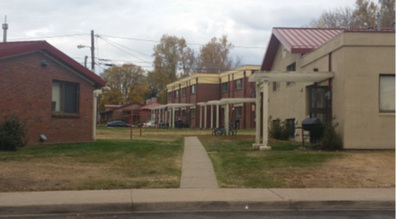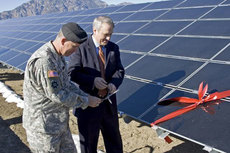Teaming Up to Make a Visible Difference in Sun Valley, CO
 Originally posted May, 2017
Originally posted May, 2017
EPA researchers are partnering with the College of Architecture and Planning at the University of Colorado, Denver (UCD) to support the revitalization of the Sun Valley Eco District community in Denver. With some 83 percent of people living below the poverty line, the community is the poorest in the Front Range region and the Denver Metro area. Recently, it has garnered increasing attention for revitalization, including a late 2016 grant of $30 million from the U.S. Department of Housing and Urban Development (HUD) to replace distressed and isolated public housing and transform the surrounding neighborhood.
The research teams from EPA and UCD are working to help the community seize the opportunity to incorporate healthy, sustainable living into planned actions.
The EPA scientists involved are from the Agency’s Sustainable and Healthy Communities (SHC) and Net Zero (see "What is Net Zero?" below) research programs, which both work directly with states and communities to help them meet their most pressing environmental challenges in ways that also improve public health and prosperity. The Sun Valley neighborhood is also one of the communities participating in EPA’s “Making a Visible Difference (MVD)” program, which matches Agency research expertise and resources with disadvantaged communities.
“The new project stems from our wider efforts within Net Zero and the Sustainable and Healthy Communities research program to partner with local universities helping communities overcome unique sustainability challenges. Sun Valley is attracting a lot of research and development support from a variety of public and private partners at local, state, and federal levels. Securing this agreement with UCD gives us at EPA an influential seat at the table to help drive even better environmental and public health outcomes for the residents of Sun Valley,” says EPA social scientist Michael Nye, Ph. D., who serves as the Net Zero Program Manager.
Nye and colleagues will work with partners at the University to combine public health and sustainability research efforts with innovative healthy community design and planning to address the challenges facing Sun Valley, included issues related to transportation, water management, energy, and food production.
UCD’s College of Architecture and Planning is actively developing sustainable urban design and planning projects in Denver, including the Sun Valley community. UCD plans to create health-oriented design studios and workshops for Sun Valley residents. SHC is also pursuing research and development projects in Sun Valley that can directly inform that work, focusing on indicators for human wellbeing and environmental quality, as well as net zero water and energy goals.
To do so, researchers will be using the Agency’s newly-launched Human Wellbeing Index (HWBI), which incorporates economic, environmental, and societal wellbeing elements in ways that show their connections to different domains such as education, health, living standards and more. Indicators like the HWBI help researchers assess current well-being conditions in a community and monitor the change in those conditions over time. Specifically, for Sun Valley, the research will assess human wellbeing with an eye toward understanding the connections between public housing and elements of the surrounding natural environment, and explore how such elements might contribute to public health even in an urban setting.
EPA plans to test and strengthen the abilities of the HWBI and indicators like it, as well as develop new indicators and metrics for Sun Valley. This will allow them to properly identify and assess the challenges facing the Sun Valley community and monitor them before, during, and after the community redevelopment process. EPA and UCD also plan to use these data to communicate Sun Valley’s challenges and successes to external stakeholders as a way to advocate for outreach for the community and others like it. A dedicated server is being set up by UCD to share data collected in this project and others at Sun Valley.
Together, EPA and UCD plan to use innovative urban planning, public health expertise, and sustainability research to help improve the lives of the residents of the Sun Valley community and their environment.
What is Net Zero?
Net Zero means consuming only as much energy as produced, achieving a sustainable balance between water availability and demand, and eliminating solid waste sent to landfills. EPA researchers have been working with the U.S. Army since 2011 to support sustainability on military installations, and continue to advance and implement Net Zero strategies, approaches, and technologies for other communities.

Learn More
